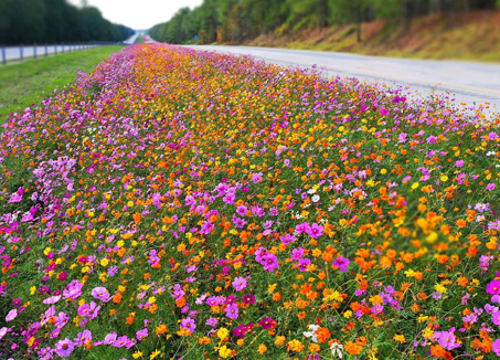The Georgia Department of Transportation and the Georgia Association of Conservation Districts or GACD are planning to install 15 pollinator habitat sites in designated locations as part of a joint effort to educate state residents about the important role “pollinators” such as bees, butterflies, and other insects play in Georgia’s agricultural sector.
[Above photo by the Georgia DOT]
“This partnership provides Georgia DOT with the unique opportunity to create a place for families and travelers to get up close and personal with the wildflowers and grasses [to] learn about how they impact the world around us,” explained Felicity Davis, a landscape architect manager with the Georgia DOT, in a statement.
“We carefully considered the locations for these gardens and with pedestrian safety in mind, we determined the best option would be at rest areas and Welcome Centers across the state,” she said.
GACD received grant funds from the U.S. Department of Agriculture’s National Resources Conservation Service to install pollinator habitat sites and promote the further establishment of such gardens by landowners throughout the state. Through a memorandum of agreement, Georgia DOT and GACD entered into a partnership to fulfill the requirements of that grant.
GACD will provide funding to Georgia DOT’s Roadside Enhancement and Beautification Council, with the department installing and maintaining the gardens while GACD provides and maintains “educational signage” about them. The grant requires both agencies to complete the planting work for those pollinator sites by August 2022.
“Pollinator plants and insects not only play a critical role in supporting our state’s environment and agriculture, but with the specific mix of wildflowers and native grass being planted, the gardens will also provide year-round interest and habitat for insects and small animals,” said Mark Masters, GACD president. “We are excited this partnership has come to fruition and look forward to getting the gardens installed.”
State departments of transportation are involved in a variety of pollinator support efforts.
The Tennessee Department of Transportation, along with the Tennessee Department of Environment & Conservation and Tennessee Department of Agriculture, jointly promoted “pollinator health and awareness” in state parks during National Pollinator Week June 21-25.
The three agencies formed a partnership in 2019 to support 64 acres of “pollinator meadows” at eight state parks. Each blooming meadow contains a mix of nectar-bearing plants and milkweed, which sustain pollinators such as bees, moths, butterflies, birds, and small mammals such as bats.
In March 2020, the American Association of State Highway and Transportation Officials sent a two-page letter to the U.S. Department of the Interior supporting “expedited approval” of the voluntary national Candidate Conservation Agreement with Assurances or CCAA to further encourage the creation of pollinator habitats in highway rights-of-way.
The CCAA – eventually finalized in April 2020 – provides a “huge boost” for the conservation of Monarch butterflies and other pollinators on a landscape scale, the U.S. Fish & Wildlife Service noted at the time.
“The regulatory protections provided by this CCAA allow transportation agencies to continue vegetation management practices with less concern that these actions will lead to an increase in the costs of regulatory compliance if the monarch is listed under the Endangered Species Act,” AASHTO said in its letter.
In December 2020, the Transportation Research Board highlighted a bevy of resources available to state departments of transportation to support monarch butterfly habitat and migration support efforts.
To that end, a new report from the TRB’s National Cooperative Highway Research Program – Evaluating the Suitability of Roadway Corridors for Use by Monarch Butterflies – provides guidance for roadside managers to determine the potential of their roadway corridors as habitat for monarch butterflies.
The report also includes several tools and decision-support mechanisms to optimize habitat potential in a manner that is compatible with the continued operation and maintenance of the roadside.


